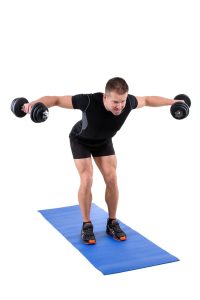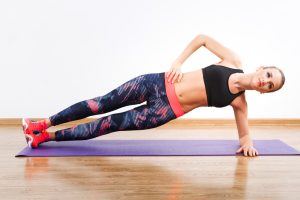 Posture is very important! Sitting all day, slouching over, and not standing straight can put a strain on your back. This can be painful and not very attractive. Below we are giving you some posture exercises to help get your posture back. At CSO, we encourage patients to seek care if experiencing any sort of back pain. For more information on the treatments we offer or to schedule an appointment contact us at 303.287.2800.
Posture is very important! Sitting all day, slouching over, and not standing straight can put a strain on your back. This can be painful and not very attractive. Below we are giving you some posture exercises to help get your posture back. At CSO, we encourage patients to seek care if experiencing any sort of back pain. For more information on the treatments we offer or to schedule an appointment contact us at 303.287.2800.
Stop right there—without moving, do a posture check. Back rounded? Chin sticking out? Don’t worry, strength training can help fix your hard-to-break slouching habits. (These yoga poses will help your tech neck too.)
Slouching doesn’t just look “blah”; it also causes neck and back pain, decreases oxygen flow to your muscles, and reduces flexibility, upping your risk of injury. This workout combats chest tightness (which exacerbates bad posture) and strengthens the muscles that pull back the shoulder blades to build better posture. (It’s one of most people’s major muscle imbalances.)
Grab some light (2- to 5-pound) dumbbells, a 6- to 10-pound weighted Body Bar, a few other odds and ends, and tackle this routine to score a sculpted upper body that not only looks tall and strong but also feels and functions better too. (No equipment handy? Try this weight-free posture workout instead.)
How it works: Two or three times a week, do 1 set of each of the first seven moves, resting for up to 60 seconds between sets. Repeat twice. Finish with one round of the neck flexion exercise and T stretch.
Total Time: up to 45 minutes
You will need: Body Bar, Free weights, Foam roller, Resistance band, Swiss ball or try this without weights!
1. “Y” Raise
A. Hold a light dumbbell in each hand and lie face-down with belly centered on a stability ball, legs extended behind you, feet wider than shoulders. Extend arms toward the ground to make a “Y,” palms facing each other.
B. Pull shoulders down and back, and then lift the arms to shoulder height, squeezing shoulder blades together. Return to starting position, and relax the shoulders.
Do 3 sets of 12 to 15 reps.
Mistakes and Tips: This move strengthens your upper back, mid-back, and scapular muscles, says Neuharth. For more back strengthening exercises, try adding these back exercises to your routine, too.
2. Right-Angle Press
A. Stand with feet shoulder-width apart and hold a weighted body bar at chest height in front of you, elbows bent 90 degrees and palms facing the ground.
B. Keep upper arms parallel to ground and rotate shoulders back, bringing bar behind your head. Lower bar to starting position and repeat.
Do 3 sets of 12 to 15 reps.
Mistakes and Tips: This move works your upper back (Try these other upper-back exercises if you want to work that area.)
3. High Row
A. Anchor the center of a resistance tube at chest height while either sitting on the floor or a stability ball. Hold both handles shoulder-width apart at chest height in front of you, palms facing the ground (tube should be taut).
B. Bend elbows, drawing hands toward shoulders. Return to starting position and repeat.
Do 3 sets of 15 to 20 reps.
Mistakes and Tips: High rows specifically target your shoulders and upper back.
 4. Reverse Fly
4. Reverse Fly
A. Hold a resistance band or tube on either end. Start with arms stretched out in front of you at chest height.
B. Keeping arms straight (but not locked) extend arms out to sides to stretch the band, squeezing shoulder blades together at the end of the movement. Return to start, keeping the movement slow and controlled.
Do 3 sets of 15 reps.
Mistakes and Tips: Overworked and tight chest muscles can result in rounded shoulders, says Miller. To fight against that, this exercise strengthens your rear deltoids (the back of your shoulder muscle) and rhomboids (the middle of your upper back). That’s why this move might just be the best posture exercise out there.
5. Quadrupled Hip Extension
A. Start on hands and knees (shoulders directly over hands, hips over knees) and engage lower abdominals. Lift one leg with knee bent at 90 degrees, bottom of the foot facing up toward the ceiling.
B. Pulse the leg up towards the ceiling while squeezing glutes, being mindful not to arch the lower back.
Do 3 sets of 15 reps.
Mistakes and Tips: By isolating your glutes in this position, you also work some of the lower back extensor muscles, as well as your deep abdominal muscles—all of which are important for maintaining good posture, says Miller.
6. Seated Low Row
A. Anchor the center of a resistance tube or band at chest height while sitting on the floor or a stability ball. Hold both ends of the band with hands facing inward.
B. Pull the cables towards you, focusing on keeping elbows close to sides and shoulders relaxed, as you squeeze shoulder blades down and back.
Do 3 sets of 15 reps.
Mistakes and Tips: When you consistently practice poor posture, your upper traps become overactive and your lower traps—the muscles that pull our shoulder blades down and back—tend to “shut off,” says Miller. While doing this exercise, make sure to pull your shoulders down and back to work the correct muscles, she says.
 7. Side Plank
7. Side Plank
A. Lie on your side, elbow directly under your shoulder. Engage lower abdominal muscles before lifting hips into the air, as you try to create a straight line from head to toes. If you need to modify, you can start on your knees.
Hold for 30 seconds to 2 minutes. Do 3 sets.
Mistakes and Tips: Many workouts fail to target the obliques or the gluteus medius (a smaller muscle in the group of three muscles that form your butt), says Miller. Planks are a total-body exercise, but side planks are specifically awesome for hitting these two muscles and improve posture by creating more stability in your low back and pelvis.
8. Neck Flexion
A. Lie faceup on a flat surface. Gently tuck chin and lift head 2 inches off the ground. Hold for 5 seconds. Lower head back to the floor, keeping the chin tucked.
Do 10 reps.
Mistakes and Tips: All those hours on your iPhone and computer give you a forward head posture, says Miller. For correct posture, you should keep your ears in line with your shoulders. To hold that posture all the time, you have to strengthen your deep neck muscles, which “act to your neck as the ‘core’ does to the back: creating stability and proper posture,” she says.
9. “T” Stretch
A. Sit in front of one end of a foam roller with knees bent and feet flat on the ground. Lie back so the head, shoulders, and upper back are on the roller; then create a “T” by extending arms out to sides, palms facing up.
Hold for 1 minute.
Mistakes and Tips: This move stretches the chest muscles, which can help release rounded shoulders.







